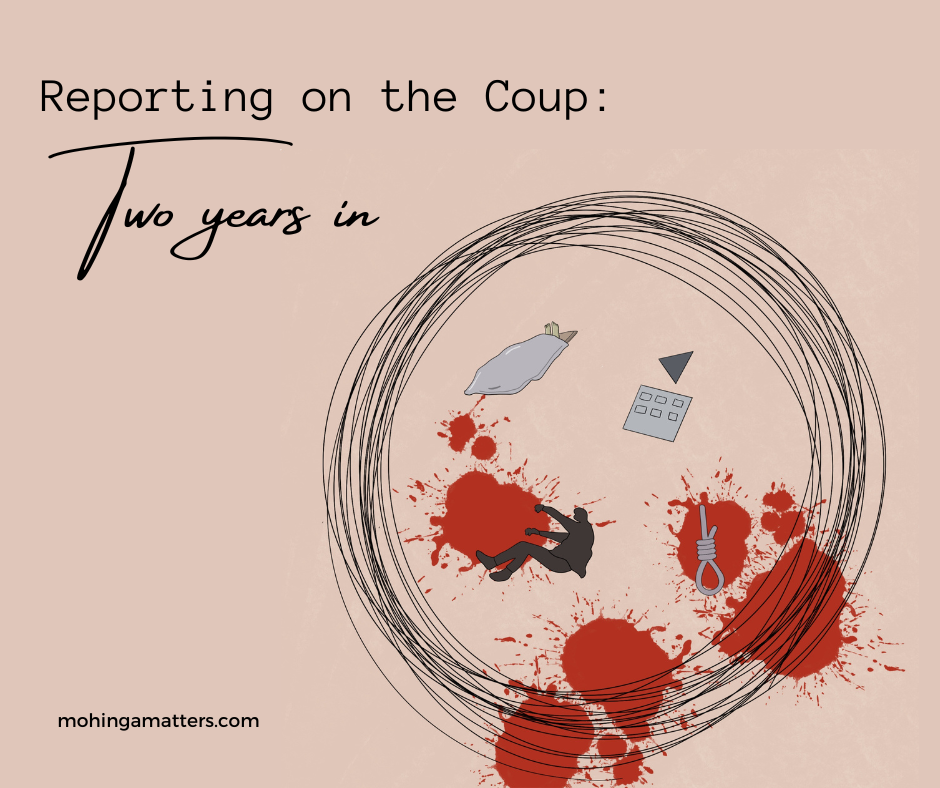
February 1, 2023, marks two years that Myanmar people have been enduring life under the military regime. As the country enters the third year of the military coup, reporting on the coup has also become increasingly challenging for local reporters, and Myanmar is no longer in the headlines of major international news outlets.
“There is still international attention on Myanmar, but compared to the early days of the coup, Myanmar-related news is no longer grabbing the international media’s headlines,” said Naw Betty Han, a journalist working for a local English-language news media outlet. She added, “I think people are becoming so normalized and desensitized with the Myanmar situation. When the coup happened in 2021, there were new developments happening almost every day in Myanmar. Mass protests against the coup. Violent crackdowns on the anti-coup protesters. Young people took up arms to resist the junta rule. Widespread clashes happened across the country. These were all new developments, but now these have sadly become a part of our daily lives.”
“In terms of Myanmar news not grabbing the international media headlines, my question is how much ‘desk space’ are they allowing for Myanmar news,” a Chiang Mai-based local reporter [requests anonymity] raised the question.
Amongst all international media outlets, Mohinga Matters monitored the coverage of Myanmar developments by five major news outlets—Reuters, BBC International, The Guardian, Aljazeera, and Associated Press between 2021 and 2022. As a Frontier Myanmar journalist said, there is still international attention on Myanmar.
For Reuters, most of the Myanmar news in 2022 was mostly coverage of international sanctions, diplomatic affairs, and scandals surrounding military families and their businesses. There was a few here and there coverage of the situations from the ground, such as arson attacks by the junta troops in some villages, but the reporting was mostly more political-focused.
Compared to Reuters, BBC International significantly has less coverage of Myanmar. Within 2022, there were only three to four news stories per month, and the coverage was sporadic and political-focused, focusing only on the biggest news of the entire month. However, there were a few feature stories highlighting the plight of the people. On January 28, 2022, BBC featured an interview with the Catholic nun from Kachin State who became one of the prominent figures of the revolution when the image of the nun kneeling in front of the soldiers during a crackdown in the early days to plead with junta soldiers not to harm the protestors.
The Guardian, on the other hand, did long-form coverage, featuring in-depth articles, interviews with the people on the frontline, and on increasing airstrikes across the country. Out of all of the international media that we monitored; Guardian is the only news outlet that published an article on December 29 detailing the junta’s involvement in the deaths of more than 160 children in 2022.
For Aljazeera, the coverage was very well-rounded. They covered everything from politics, and international developments to other aspects of the coup, such as publishing long-form investigations on doxing, landmine victims, and Rohingya plights. Out of the five international media outlets, Aljazeera had the most coverage on Myanmar and they ensured coverage of the crackdown on journalists, ethnic conflicts after the coup, UN developments, and women’s struggles in 2022.
Associated Press coverage of Myanmar in 2022 has been disappointing. During the first year of the coup, the AP team did investigations into underground clinics, tortures and atrocities occurring in the detention centers, and the mass arrest of young boys by the junta forces. In 2022, AP covered exclusively international developments and how the international community is responding to the atrocities happening in the country.
Challenges of the Local Reporters
During 2022, violence across the country continues to overwhelm communities within the country, with junta soldiers and forces launching offensive and defensive attacks against armed resistance forces, ethnic armed groups as well as civilians. With multiplying fighting, there are more incidents to report on, and the question of which incidents, which casualties, and which humanitarian crisis should be highlighted and singled out becomes a dilemma that most reporters and news outlets have to deal with on a daily basis as there is the violence happening every day, everywhere.
“After the coup, our reporting work becomes harder year after year,” said a local reporter based in Chiang Mai, Thailand, who requested anonymity. “There are thousands of Myanmar journalists, but only a handful of the journalists can operate on the ground to get the news out, and it is a lot of pressure on them,” he added. Within two years, about 130 journalists have been arrested and jailed, and 72 are still being held in detention, according to the latest figures from Reporters Without Borders. The crackdown on journalists saw four Myanmar journalists killed since February 1, 2021.
“I left the country at the end of 2021, and it is infinitely harder for us journalists to talk to our sources and follow the news,” Naw Betty Han said. “Before leaving, it was much easier to reach out to sources in Kachin State and Mandalay Region even though I was based in Yangon. Everything was just a phone call away, and any developments happening across the country, I am on top of them,” she added.
Despite the crackdown, there are a few reporters who continued to report on the developments happening in the country while trying their best to stay off the junta’s radar.
A 30-year-old local reporter with a decade of experience working as a journalist said, “I think all of the local news outlets continue to report as much as possible on almost all incidents happening in Myanmar right now.” The journalist requested anonymity in fear of retribution as he is still operating inside the country.
According to him, ongoing violence in 2022 saw more civilian casualties and the rate of civilians being collateral damages in the fighting between the junta forces and the opposition rose. So naturally, he said that most reporters went back to focusing on how many civilians are being killed, injured, and affected by these nationwide fights rather than who won and lost in the fighting or how many junta soldiers and PDF members are being killed.
“For example, the news about a village being raided by junta soldiers — we would put the headline on how many residents had to flee and abandon their homes and how their lives are heavily affected,” he said. If he is reporting on a raid with causality, he said, “Let’s say there are six People’s Defense Force [PDF] members and one child who were killed during the incident, I would put the death of a child or civilians as the headline rather than the six PDF members whose lives were also taken during the incident.”
When asked about whether it’s harder to highlight or single out a story in this violence-filled time, he disagreed that civilian casualties, especially when it comes to children, are being underreported. “Whether we are talking about local news outlets or the Myanmar section of the international outlets, I don’t agree that news [about instability and violence toward the women, children, and the elders] are less covered,” he said.
Stakeholders’ Role in Shining Spotlight on Myanmar Crisis
As discovered above, only two out of five news outlets that Mohinga Matters monitored covered news on vulnerable populations. This issue was also highlighted in an article written by a freelance journalist, Mratt Kyaw Thu on November 25, 2022.
Mratt gave an example of incidents that happened in November in which the death of two young children went underreported by the media outlets. On November 16, a 6-year-old child from Rakhine State’s Maungdaw Township was killed by heavy artillery and in another incident on November 24, a 7-year-old boy who was tending cattle was killed when Mong Hla village in Maungdaw was torched and attacked by a junta’s air strike.
Mratt wrote that both incidents were reported by the local news but there was no coverage as headline news in an international media outlet. He compared these two incidents to the international coverage of two Syrian children who were collateral damages of the conflicts in 2015 and 2016.
He said, “It is no longer an unusual event for people in Myanmar since people are dying every day. But the issue of children dying in the most violent way is something that should be covered by the international press.”
His solution for this is that the media outreach team under the National Unity Government, which is responsible for media outreach and lobbying, should pay close attention. “They can’t just rely on the media outlets and say this is news, so it’s the job of the media to report on these. They need to be at the forefront of these coverages and spread public awareness to ensure that a spotlight is shone on this internationally,” said Mratt.
International media outlets failed to continue putting a spotlight on the struggles of women and children, which ramped up even more now. But on the other hand, the whole country is burning right now, so we have news about villages burning down, junta soldiers or PDF members being killed, as well as the coverage of kids dying as a result of the conflicts and violence committed by the junta soldiers.
Sometimes, the coverage didn’t get widespread recognition due to every possible atrocity occurring in Myanmar right now. But this shouldn’t be normalized. The world shouldn’t forget that people across Myanmar, especially women, and children, continued to live in fear under the military regime, and this revolution is not a lost cause. People have yet to give up, and the world shouldn’t give up on Myanmar.

